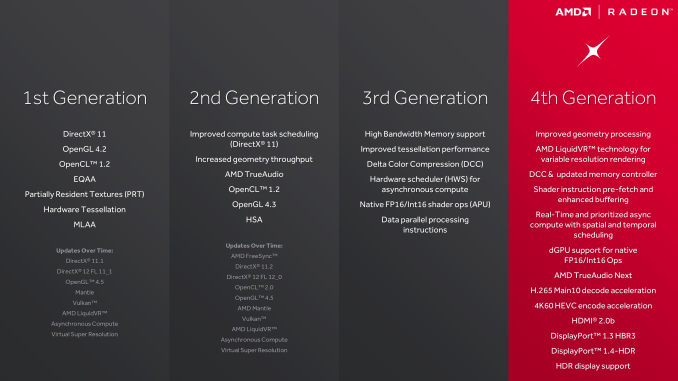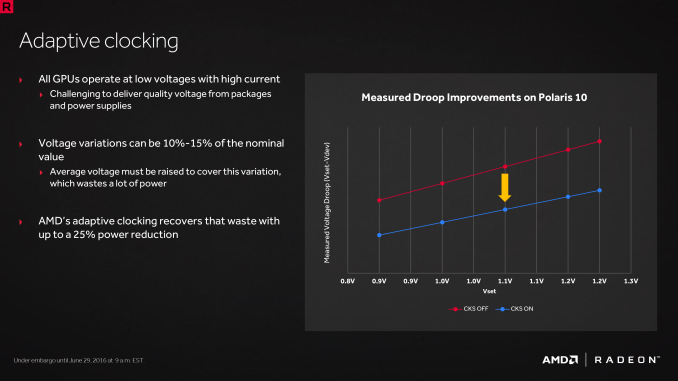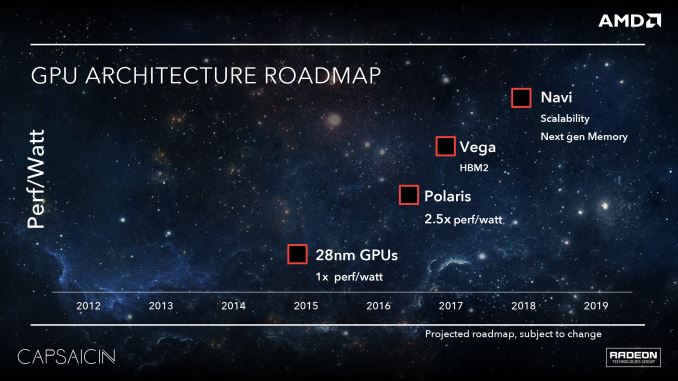The AMD Radeon RX 480 Preview: Polaris Makes Its Mainstream Mark
by Ryan Smith on June 29, 2016 9:00 AM ESTAMD's Path to Polaris
With the benefit of hindsight, I think in reflection that the 28nm generation started out better for AMD than it ended. The first Graphics Core Next card, Radeon HD 7970, had the advantage of launching more than a quarter before NVIDIA’s competing Kepler cards. And while AMD trailed in power efficiency from the start, at least for a time there they could compete for the top spot in the market with products such as the Radeon HD 7970 GHz Edition, before NVIDIA rolled out their largest Kepler GPUs.
However I think where things really went off of the rails for AMD was mid-cycle, in 2014, when NVIDIA unveiled the Maxwell architecture. Kepler was good, but Maxwell was great; NVIDIA further improved their architectural and energy efficiency (at times immensely so), and this put AMD on the back foot for the rest of the generation. AMD had performant parts from the bottom R7 360 right up to the top Fury X, but they were never in a position to catch Maxwell’s efficiency, a quality that proved to resonate with both reviewers and gamers.
The lessons of the 28nm generation were not lost on AMD. Graphics Core Next was a solid architecture and opened the door to AMD in a number of ways, but the Radeon brand does not exist in a vacuum, and it needs to compete with the more successful NVIDIA. At the same time AMD is nothing if not scrappy, and they can surprise us when we least expect it. But sometimes the only way to learn is the hard way, and for AMD I think the latter half of the 28nm generation was for the Radeon Technologies Group learning the hard way.
So what lessons did AMD learn for Polaris? First and foremost, power efficiency matters. It matters quite a lot in fact. Every vendor – be it AMD, Intel, or NVIDIA – will play up their strongest attributes. But power efficiency caught on with consumers, more so than any other “feature” in the 28nm generation. Though its importance in the desktop market is forum argument fodder to this day, power efficiency and overall performance are two sides of the same coin. There are practical limits for how much power can be dissipated in different card form factors, so the greater the efficiency, the greater the performance at a specific form factor. This aspect is even more important in the notebook space, where GPUs are at the mercy of limited cooling and there is a hard ceiling on heat dissipation.
As a result a significant amount of the work that has gone into Polaris has been into improving power efficiency. To be blunt, AMD has to be able to better compete with NVIDIA here, but AMD’s position is more nuanced than simply beating NVIDIA. AMD largely missed the boat on notebooks in the last generation, and they don’t want to repeat their mistakes. At the same time, starting now with an energy efficient architecture means that when they scale up and scale out with bigger and faster chips, they have a solid base to work from, and ultimately, more chances to achieve better performance.
The other lesson AMD learned for Polaris is that market share matters. This is not an end-user problem – AMD’s market share doesn’t change the performance or value of their cards – but we can’t talk about what led to Polaris without addressing it. AMD’s share of the consumer GPU market is about as low as it ever has been; this translates not only into weaker sales, but it undermines AMD’s position as a whole. Consumers are more likely to buy what’s safe, and OEMs aren’t much different, never mind the psychological aspects of the bandwagon effect.
Consequently, with Polaris AMD made the decision to start with the mainstream market and then work up from there, a significant departure from the traditional top-down GPU rollouts. This means developing chips like Polaris 10 and 11 first, targeting mainstream desktops and laptops, and letting the larger enthusiast class GPUs follow. The potential payoff for AMD here is that this is the opposite of what NVIDIA has done, and that means AMD gets to go after the high volume mainstream market first while NVIDIA builds down. Should everything go according to plan, then this gives AMD the opportunity to grow out their market share, and ultimately shore up their business.
As we dive into Polaris, its abilities, and its performance, it’s these two lessons we’ll see crop up time and time again, as these were some of the guiding lessons in Polaris’s design. AMD has taken the lessons of the 28nm generation to heart and have crafted a plan to move forward with the FinFET generation, charting a different, and hopefully more successful path.
Though with this talk of energy efficiency and mainstream GPUs, let’s be clear here: this isn’t AMD’s small die strategy reborn. AMD has already announced their Vega architecture, which will follow up on the work done by Polaris. Though not explicitly stated by AMD, it has been strongly hinted at that these are the higher performance chips that in past generations we’d see AMD launch with first, offering performance features such as HBM2. AMD will have to live with the fact that for the near future they have no shot at the performance crown – and the halo effect that comes with it – but with any luck, it will put AMD in a better position to strike at the high-end market once Vega’s time does come.













449 Comments
View All Comments
stereopticon - Wednesday, June 29, 2016 - link
the gtx 970's price could easily be dropped to 240 to competesmilingcrow - Wednesday, June 29, 2016 - link
In the UK the 970 is already cheaper than the RX 480 8GB if you shop around which is where it should be priced I think.The RX 480 only has one redeeming feature but that's an important one; PRICE.
ptmnc1 - Wednesday, June 29, 2016 - link
Well, it *could*, I suppose. But the 970 is a 398mm² chip and the 480 is a 232mm² chip so AMD can make 1.7x as many from the same wafer even before accounting for yields. With similar memory systems there's no way for nVidia to win a price war at this performance level with its 28nm parts.DigitalFreak - Wednesday, June 29, 2016 - link
AMD has no monies to fight a price war. Nvidia could drive them out of the market right now if they wanted to. They won't because of monopoly concerns.ptmnc1 - Wednesday, June 29, 2016 - link
nVidia can't flog 970s below cost without various anti-dumping laws kicking in as well as the risk of having their company disassembled. Plus AMD would still be making a profit at that point.Yojimbo - Thursday, June 30, 2016 - link
I'm pretty sure that NVIDIA wouldn't have to sell the 970 for below cost to use it to compete or even undercut the current MSRP of the RX 480. NVIDIA's profit margins are significantly higher than AMD's to begin with. If NVIDIA prices the GTX 970 at just below the price as the RX 480, they probably sell more of them than AMD sells of the RX 480s. A price of the 970 GPU to AIB partners which would allow them to sell their card for $180 should not be below cost. I really don't know how such accounting works, but I am guessing that most of the research, development, and validation costs have already been amortized. Production cost of the chip really is not that much, comparitively. Surely regulators must recognize a cost advantage of a long-run production of a product.fanofanand - Thursday, June 30, 2016 - link
I'm not sure anti-dumping laws apply to obsolete (based on not being the latest) hardware. How else would a company be expected to clear out existing inventory prior to a product refresh?ptmnc1 - Thursday, June 30, 2016 - link
Yojimbo: The 970 has almost exactly the same memory system as the 4GB 480, the only differences in manufacturing costs are going to be the other parts of the board (e.g. VRMs) and the chip itself. The principal cost difference is going to be the chip, and when it's a 232mm² chip vs a 398mm² chip, the latter is going to cost a lot more to make even if yields on Samsung's 14LPP aren't as great as TSMC's 28nm: as long as they're not catastrophically worse (and there's no indication that's the case), there's just no way to build a 970 cheaper than a 4GB 480.On monopolies, you don't have to abuse one in order to attract a lot of undesirable attention from regulators.
fanoffanand: There's a difference between clearing existing obsolete inventory and deliberately manufacturing new inventory at a loss for the purpose of pushing a competitor out of business.
Yojimbo - Thursday, June 30, 2016 - link
The major cost of a chip is research, development, testing, and validation, not manufacturing costs. I assume these costs must be amortized over the life of the product. I am guessing that NVIDIA has already mostly done so, because they have sold a whole lot of chips already. You are worried about dumping, well how can the government come in and say NVIDIA is selling below cost when their research, development, testing, and validation costs logically apply over a run of 2 years, during which they already sold a high volume of chips?Regardless of whether it costs more or less for NVIDIA to make a 970 than AMD an RX 480 (I agree that the AMD RX 480 production costs should be lower), I feel confident in saying that NVIDIA doesn't need to sell at below cost to sell a 970 at a price below $200.
"On monopolies, you don't have to abuse one in order to attract a lot of undesirable attention from regulators."
Regulators don't just sit there and watch everything. NVIDIA would have to be sued for abuse of power, i.e., some company would need to be willing to spend money to oppose NVIDIA. If NVIDIA does not abuse its market position they shouldn't be too concerned with losing such a suit. If they don't plan on making any aquisitions in the GPU space then i think they don't need to worry about regulators. I'm mainly just repeating what I already said here, but you aren't saying what sort of "undesirable attention" you see NVIDIA getting or how it will affect them, so I'm not sure what else I can do.
fanofanand - Friday, July 1, 2016 - link
Nvidia isn't currently manufacturing new 970s.